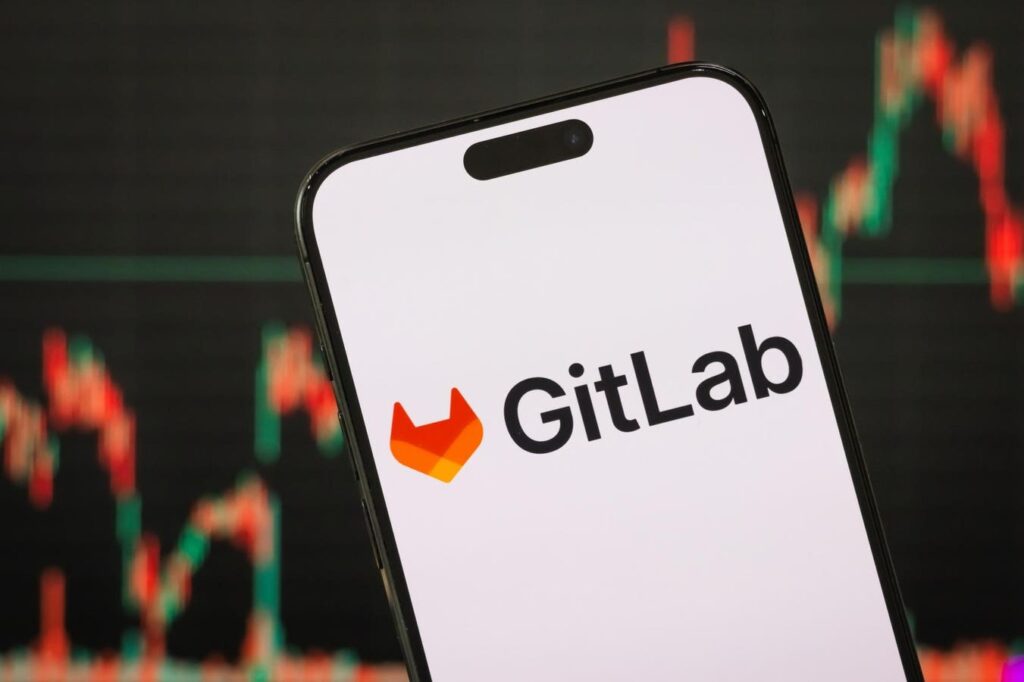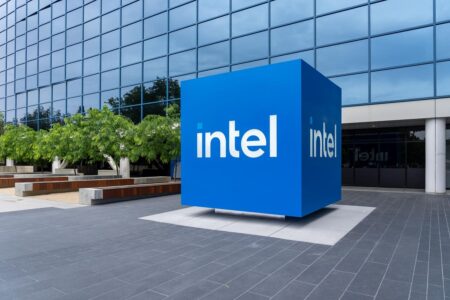I originally put Gitlab Inc. (GTLB) in the Danger Zone on October 8, 2021 prior to its IPO. Since the company’s IPO, it has outperformed as a short.
Despite the outperformance as a short, this stock remains dangerous. After analyzing GitLab’s fiscal year 2025 10-K, my short thesis still stands. The company is dwarfed by its competition, remains unprofitable, and its stock price is too expensive and offers much more downside risk than upside potential.
GitLab’s stock could fall further based on:
- the inability to convert free users into paying ones,
- slowing recurring revenue growth from its paying customer base,
- more profitable competition, and
- a stock valuation that implies GitLab will grow its market share nearly 5x in an industry dominated by much larger and stronger companies.
What’s Working
GitLab grew its total revenue 31% year-over-year (YoY) in fiscal 2025. Additionally, in fiscal 2025, the number of customers that generate:
- more than $5,000 of annual recurring revenue (ARR) increased 15% YoY.
- more than $100,000 of ARR increased 29% YoY.
- more than $1 million of ARR increased 28% YoY.
The company also beat on both the top- and bottom-line when it reported fiscal 4Q25 results.
What’s Not Working
Just focusing on top-line growth, rather than trends, would be short-sighted. For instance, the customer segments noted above all grew at lower YoY growth rates in fiscal 2025 than in fiscal 2024. Slowing top-line growth is just one of the concerns of investing in GitLab at current levels, as I’ll show below.
Conversion Rate Is Not Nearly High Enough
The freemium business model has been around for many years, and industry analysis estimates that most software-as-a-service (SaaS) companies have a 2%-5% freemium conversion rate. Conversion rate refers to the percentage of free users converted into paying users.
There’s no doubt GitLab has successfully attracted users. Its total registered users have increased from an estimated 30 million in fiscal 2024 to “more than 50 million” in fiscal 2025. Over the same time, GitLab’s base customers, which are the customers that generate more than $5,000 in ARR, increased from 8,602 to 9,893. In other words, in a time when the company’s reported estimate of registered users increased 20 million, its base customers increased by 1,291, much less than the average 2-5% conversion noted above.
The number of customers that generate higher ARR is also still a small portion of the company’s base customers. In fiscal 2025, the number of customers that generate more than $100,000 and more than $1 million in ARR were 1,229 and 123, respectively.
GitLab’s revenue is largely dependent on converting free users into paying users. The fact that the company converts so few continues to be alarming.
Figure 1: GitLab’s Revenue and NOPAT: Fiscal 2020 – 2025
Existing User Upsells Are Slowing Too
As GitLab converts fewer free users to paid users, the recurring revenue generated by existing users is growing at slower rates in recent years.
The company measures its ability to retain and expand revenue generated by its existing customers in the form of dollar-based net retention rate, which is calculated by the dividing the current period ARR by the previous period ARR derived from its customer base at a point in time.
GitLab’s dollar-based net retention rate fell from over 145% in fiscal 2021 to 123% in fiscal 2025. See Figure 2.
Figure 2: GitLab’s Dollar-Based Net Retention Rate: Fiscal 2021 – Fiscal 2025
Small Market Share Dwarfed by Industry Leaders
GitLab’s closest competition comes from industry giant Microsoft (MSFT), which owns GitHub after acquiring the company in 2018. Other competitors include large tech/cloud players such as Amazon (AMZN), Alphabet (GOOGL), Oracle (ORCL), International Business Machines (IBM), and Atlassian Corp (TEAM). The broad cloud services market is dominated by established tech companies that are consistently looking to take market share.
More specifically, GitLab operates in the DevSecOps (development, security, and operations) market, which is a segment of the infrastructure as a service industry. The global DevSecOps market size was estimated to be worth $8.8 billion in 2024, which would give GitLab an approximate market share of 9% based on revenue. On the user front, Gitlab’s estimated 50 million registered users would still be half of the 100 million users GitHub reported in 2023. To calculate GitLab’s estimated current market share, I divided the company’s fiscal 2025 revenue (ending January 31, 2025) of $759 million by the global DevSecOps market size at the end of 2024, which was $8.8 billion.
Not only do industry incumbents have more users and resources than GitLab, but they are significantly more profitable. Even though GitLab’s net operating profit after-tax (NOPAT) has improved, it is still negative. Per Figure 3, GitLab has the lowest NOPAT margin and return on invested capital (ROIC) in the industry.
Figure 3: GitLab’s Profitability Vs. Peers: TTM
Taking market share in an industry mainly occupied by behemoths will be hard for GitLab, especially considering that GitLab’s revenue is 100% dependent on its DevSecOps operations, while its competitors have many other revenue streams and are more profitable.
Cash Burn Continues Onward
On top of negative NOPAT, GitLab is burning cash.
Since fiscal 2021, GitLab’s free cash flow (FCF) has been negative on an annual basis every year except one (it generated $7 million in FCF in fiscal 2024). On a quarterly basis, Gitlab’s FCF has been negative in 11 of the 12 quarters in my company model.
From fiscal 2020 through fiscal 2025, GitLab has burned through a cumulative $1.4 billion (16% of enterprise value) in FCF excluding acquisitions. See Figure 4.
Following the same trend, the company’s economic earnings, the true cash flows of the business that take into account changes to the balance sheet, fell from -$163 in fiscal 2020 to -$194 in fiscal 2025.
Figure 4: GitLab’s Cumulative Free Cash Flow Since Fiscal 2021
Valuation Implies GitLab Will Grow Its Market Share 5x
Below, I use my reverse discounted cash flow (DCF) model to analyze the future cash flow expectations baked into GitLab’s stock price. GitLab’s stock is priced as if it will grow revenue at accelerated rates and will 5x its current market share in the DevSecOps industry. I also present additional DCF scenarios to highlight the downside risk in the stock if GitLab fails to achieve these overly optimistic expectations.
To justify its current price of $48/share, my model shows GitLab would have to:
- improve its NOPAT margin to 17% (equal to IBM’s 2024 NOPAT margin, compared to GitLab’s -12% fiscal 2025 NOPAT margin) and
- grow revenue by 33% compounded annually (2.5x projected industry growth through 2030) for the next decade.
In this scenario, GitLab would generate $13.1 billion in revenue in fiscal 2035, which is 17x the company’s fiscal 2025 revenue. This scenario also implies GitLab’s NOPAT would reach $2.2 billion in fiscal 2035, compared to the company’s -$93 million NOPAT in fiscal 2025. For reference, ServiceNow (NOW), a much larger and profitable SaaS company, generated $1.2 billion in NOPAT in 2024.
The implied revenue in this scenario would be 40% of the estimated global DevSecOps market in 2034, which is far above the company’s estimated market share of 9% in 2024. To estimate the global DevSecOps market size in 2034, I assume the industry continues to grow at the projected 2025-2030 industry CAGR of 13.2% from 2031-2034 to calculate a projected market size of $33.2 billion.
Furthermore, companies that grow revenue by 20%+ compounded annually for such a long period are “unbelievably rare”, making the expectations in GitLab’s share price even more unrealistic.
38%+ Downside If Revenue Grows at 2x Projected Industry Growth Rate
If I instead assume GitLab:
- immediately improves NOPAT margin to 17% and
- grows revenue by 26% (2x projected industry growth) compounded annually each year through fiscal 2035, then
the stock would be worth $30/share today – a 38% downside to the current price.
In this scenario, GitLab would grow revenue to $7.7 billion in fiscal 2035, which would be over 10x the company’s fiscal 2025 revenue. This scenario also implies GitLab achieves a NOPAT of $1.3 billion in fiscal 2035, which is still far above the company’s NOPAT in fiscal 2025. $1.3 billion in NOPAT would be almost 3x higher than Workday’s (WDAY) fiscal 2025 NOPAT.
The implied revenue in this second scenario would represent 23% of the DevSecOps market in 2034, which is still nearly triple the company’s market share in 2024.
75%+ Downside If Revenue Grows at Projected Industry Growth Rate
If I instead assume GitLab:
- immediately improves NOPAT margin to 17% and
- grows revenue by 13% (projected industry growth) compounded annually each year through fiscal 2035, then
the stock would be worth just $12/share today – a 75% downside to the current price.
Figure 5 compares GitLab’s implied future NOPAT in these scenarios to its historical NOPAT. For additional comparison, I include the TTM NOPAT of profitable SaaS companies ServiceNow (NOW) and Workday (WDAY).
Figure 5: GitLab’s Historical and Implied NOPAT: DCF Valuation Scenarios
Stock Is Not Worth $1
Each of the above scenarios assumes GitLab grows revenue, NOPAT and FCF without increasing working capital or fixed assets. This assumption is highly unlikely but allows me to create best-case scenarios that highlight the unrealistically high expectations embedded in the current valuation. For reference, GitLab’s invested capital grew 23% compounded annually from fiscal 2020 through fiscal 2025. If I assume GitLab’s invested capital increases at a similar rate in the DCF scenarios above, the downside risk is even larger.
Given that the performance required to justify its current price is overly optimistic, I dig deeper to see if GitLab is worth buying at any price. The answer is no.
The company has $45 million in minority interests, <$1 million in deferred tax liabilities, $140 million in outstanding employee stock options, and no excess cash. GitLab has an economic book value, or no-growth value, of -$5/share. In other words, I do not think equity investors will ever see $1 of economic earnings under normal operations, which means the stock would be worth $0 today.
Read the full article here











